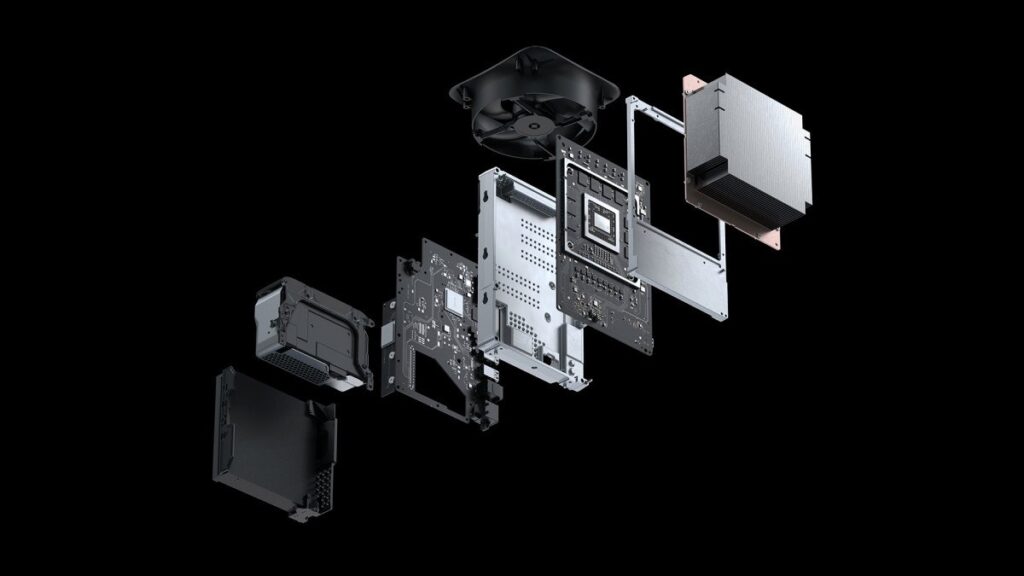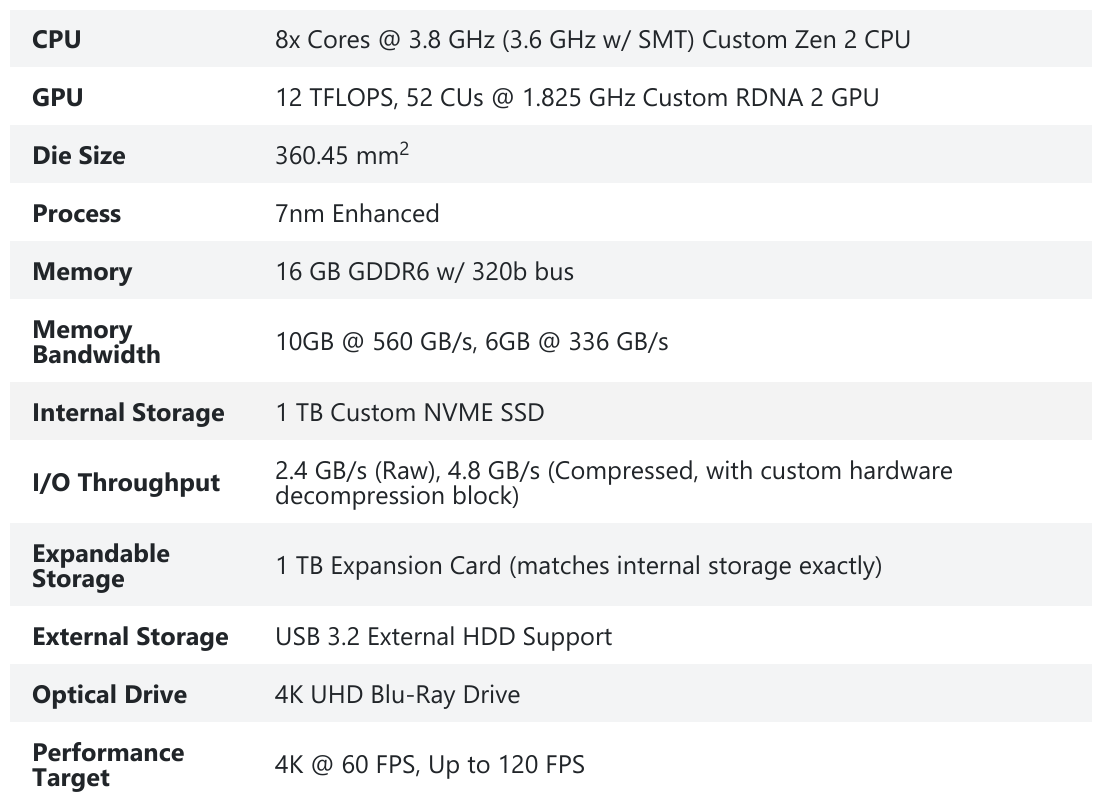
In late February, the Xbox team unveiled new Series X features like Smart Delivery and Quick Resume while confirming a majority of tech specifications for the next-gen console. Today, not even a month later, Microsoft has once again offered a fresh look at some of what makes the Xbox Series X architecture tick. A full listing of the new console’s specs is below, but what’s possibly more interesting is how Microsoft showed off the fast response of the Quick Resume feature and how games can now load incredibly quickly.

Fast load times are aided by a solid state drive (SSD), and Series X owners will even be able to go beyond the internal 1TB of storage space with storage expansion cards that are designed to “replicate the console’s internal custom SSD experience.” The SSD is important, but it’s further enhanced by what Microsoft has dubbed “Xbox Velocity Architecture.”
The SSD pairs with “a dedicated hardware decompression block, the all new DirectStorage API, and Sampler Feedback Streaming (SFS)” to allow developers “to radically improve asset streaming and effectively multiply available memory. It will enable richer and more dynamic living worlds unlike anything ever seen before. It also effectively eliminates loading times, and makes fast travel systems just that: fast.”
Microsoft pointed to vast, sprawling games like Red Dead Redemption 2 or Assassin’s Creed Odyssey and how players shouldn’t need to worry about immersion-breaking segments that deliberately hide assets loading in.
“The CPU is the brain of our new console and the GPU is the heart, but the Xbox Velocity Architecture is the soul,” said Andrew Goossen, Technical Fellow on Xbox Series X at Microsoft. “The Xbox Velocity Architecture is about so much more than fast last times. It’s one of the most innovative parts of our new console. It’s about revolutionizing how games can create vastly bigger, more compelling worlds.”
From a usability standpoint, the Quick Resume feature is sure to please many Series X owners. Similar to how a majority of smartphones can easily toggle back and forth between numerous open apps, this function allows players to continue right where they left off even if they’ve suspended a lot of intense, AAA game sessions. But it goes beyond the phone-style functionality because a user can turn off and unplug the console, and it’ll still work thanks to SSD storage. Microsoft boasted, “One of the testers on the team unplugged his console for a week, then took an update, and was still able to continue right where he left off without so much as a loading screen.”
Beyond the “Velocity Architecture,” with raytracing-enhanced visuals, upgrades to older titles through backwards compatibility, and the full ecosystem support of Smart Delivery, Xbox Series X should have plenty to offer fans. That said, we can’t help but notice the huge discrepancy in approach to next-gen from Xbox and PlayStation. While the Xbox team has been deliberately drip feeding the community information about the new hardware, Sony has been eerily silent.
Piers Harding-Rolls, Research Director of Games at Ampere Analysis, believes Microsoft is acting from a position of weakness. “Microsoft has had to take the initiative in the run up to the new generation because Sony’s position globally is so much stronger,” he told GameDaily. “That means a more constant drip feed of information from Microsoft, which is in contrast to Sony’s more restrained approach. I don’t think Sony’s pre-launch strategy has really changed from the run up to the launch of PS4 – Microsoft has just been more active.”
For Lewis Ward, IDC’s Research Director of Gaming, Sony’s reticence to share anything about the PS5 may stem from the dust settling within the organization after much restructuring. And it was only last November that Sony appointed former Guerilla Games boss Hermen Hulst to oversee Worldwide Studios.
“Sony, from my perspective, has been really quiet across the board on gaming since the beginning of the year. I was at CES 2020 and so was Sony but we didn’t meet since all they unveiled was a logo,” Ward commented. “There’s been a lot of turnover within SIE. I think generational changes are a time within SIE where if you want to go do something else in the company or elsewhere it’s viewed as the best time to step away.
“On top of that, with this whole COVID-19 pandemic, they’ve been out front in terms of pulling out of shows and events. They were among the first to drop out of GDC and PAX East and so on. So it may be that the company in general has been more locked down than others as they struggle to come to grips with what it means internally and externally for the business.”
With the coronavirus outbreak in mind, there’s been plenty of speculation that one or both next-gen launches could be delayed into 2021. Microsoft’s newest promotional videos for Xbox Series X do still indicate a Holiday 2020 launch, and you could possibly infer that the company’s continued information push hints at some confidence that it will indeed meet that launch goal.
Ward expects Sony to “go big” on PS5 “once they feel confident that the disruptions caused by COVID-19 are at least well understood and gamers are feeling confident enough about their own finances to be ready to invest in next-gen hardware.” However, neither company is at a greater disadvantage because of the pandemic, he said.
“I think they’re roughly equally disrupted,” Ward added. “I know the whole U.S. trade barrier scare forced Sony, Microsoft and Nintendo to scramble to find alternative production facilities… I think both consoles will still arrive in late 2020 but in smaller volumes than either Sony or Microsoft originally planned. All it takes is one missing or very limited component and the whole supply chain production process gets a monkey wrench (and extra cost) thrown into it. We’ve modeled out a few different scenarios for China’s recovery, and we currently expect the supply chains and production processes to take about six months to get back on track. Exactly how much of a console production slowdown that means is impossible to know today.”
Harding-Rolls is a bit more optimistic but he conceded that delayed launches for either console could very much still happen.
“…at this stage it is business as usual for both Sony and Microsoft. It sounds like Chinese assembly line capacity is continuing to improve. As we predict that production disruption would only occur in Q2 onwards during the build-up for the launch, things are looking more positive,” he noted. “However, there remains some unknowns around the status of component availability for next-gen consoles, and I think there are highly likely to be some component bottlenecks which need to be ironed out. Overall, I think next-gen consoles will be lucky to get away with no impact from the coronavirus outbreak, but that might not necessarily mean a constrained or delayed launch for either company.”
Manufacturing issues aside, there’s also the PR part of the equation. If the coronavirus is still plaguing nations around the world by the end of this year, the optics of these console launches could look bad. “Obviously if the world isn’t largely in recovery mode from COVID-19 by the start of 4Q20, then it may come off as tone deaf to launch these new consoles into that environment,” Ward warned. “Put another way, yes, I think the door is open to a 2021 launch if the pandemic gets a lot worse globally through 2Q20.”
Whenever the Xbox Series X launches, fans are likely to get excited. Microsoft has yet to reveal critical details such as pricing and launch lineup, but with a digital event now planned to take place during what would have been E3 2020, June should offer plenty more clarity around what to expect. As for when we might hear more PS5 details from Sony, we can only speculate. COVID-19 is forcing companies across all industries to reconsider plans.
 GameDaily.biz © 2025 | All Rights Reserved.
GameDaily.biz © 2025 | All Rights Reserved.